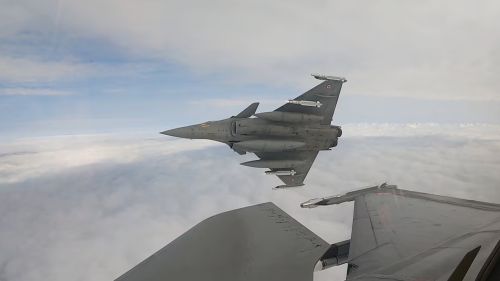

The frontier between NATO and Russia is no longer a line of maps and treaties. It is a contested space in the air, where machines cross and defenses respond.

By Matthew A. McIntosh
Public Historian
Brewminate
Introduction: A Quiet Morning Turns Confrontational
In the early hours over Poland, radar screens lit up with intrusions. Within minutes, NATO air defenses engaged, destroying several Russian drones that had crossed into Polish airspace. Debris scattered across farmland, no civilians were hurt, but the symbolism was unmistakable.
The incident is not just about drones. It is about borders that are no longer abstract lines but fragile membranes, tested by Moscow and defended by an alliance that now finds itself pulled closer to confrontation.
The Incident in Polish Skies
Polish officials reported that at least three drones entered from Ukrainian airspace. NATO’s integrated defense systems responded quickly, neutralizing them before they reached populated areas. Villagers in the region later found fragments of twisted metal in fields, reminders that the war next door is not always contained by maps.
Russia has not accepted responsibility. State outlets floated claims of technical malfunctions, even suggesting Ukrainian “provocations.” But the pattern is hard to ignore. For months, Russian drones have hovered near NATO’s borders, their paths probing for weakness. This time, the drones crossed too far, and the alliance acted.
NATO’s Response: From Caution to Muscle
In Brussels, the tone hardened. For years, NATO walked a line between deterrence and escalation, responding to border incidents with warnings rather than weapons. Shooting down the drones broke that pattern.
Within hours, additional units were dispatched eastward. Poland announced the arrival of fresh air-defense batteries, and AWACS surveillance flights increased over the Baltics. Quick-reaction fighter squadrons have been placed on higher alert. Officials insist these moves are defensive, but the build-up feels different: less reassurance, more preparation.
For people living near the frontier, the sky now hums with aircraft. The presence is both a comfort and a constant reminder that the conflict is pressing closer.
Historical Resonance and Strategic Stakes
For Poland, this episode is not just about the present. The country has lived through centuries of invasion: carved up by empires, occupied by Nazis, crushed by Soviet tanks. The idea of Russian craft, even unmanned, crossing its border cuts deep into memory. It echoes a past many Poles believed they had finally buried when they joined NATO in 1999.
Strategically, the incident underscores the central dilemma of deterrence. NATO must respond firmly enough to prove resolve, yet not so forcefully as to trigger escalation. Each drone shot down walks that line. Each reinforcement on the eastern flank is a bet that Moscow will hesitate before pushing further. But deterrence only works if both sides read the signals the same way. History shows that misreading is always possible.
Moscow’s Calculus
Why test NATO at all? Analysts suggest Russia’s motives may be layered. The drones could be reconnaissance, mapping NATO’s radar responses. They could also be psychological, a message to border populations that their safety is precarious.
Some argue it is political theater. By sending drones across NATO borders, even briefly, Moscow blurs the threshold of Article 5. Was it an accident? Was it hostile intent? If the line is made ambiguous, Russia gains room to maneuver. It can apply pressure without formally triggering the collective defense clause.
Others point out that Russia thrives on constant tension. By keeping NATO guessing, by forcing the alliance to shift resources eastward, Moscow stretches its adversaries without firing a shot.
The View from the Ground
For people living in the Polish countryside, these grand strategies manifest in sudden, jarring ways. One farmer described hearing the crack of interceptors overhead and later finding a jagged piece of drone fuselage in his orchard. “The war fell into my trees,” he said to a local reporter.
In Warsaw, the reaction has been conflicted. Some applaud the shootdowns as a declaration that sovereignty will be protected at all costs. Others whisper fears of becoming the flashpoint for a wider war, the place where an accident spirals into global conflict. Cafes buzz with conversations that mix pride, anger, and unease. The frontline may be hundreds of miles east, but in moments like these it feels only a field away.
The Wider European Context
The incident lands at a time of war fatigue across Europe. Support for Ukraine remains strong in principle, but publics are weary of the costs. Governments are stretched between domestic crises and foreign commitments. Into this climate, Russian drones in NATO airspace arrive like a jolt. They remind everyone that the conflict is not distant. It is pressing against the alliance itself.
For NATO leaders, unity is the most precious commodity. Reinforcements require resources, and resources require consensus. A divided alliance would be easy prey for Moscow’s divide-and-rule tactics. The drones may have been small, but they test not just radars but cohesion.
Conclusion: A Border Redefined
The downing of Russian drones over Poland marks a subtle but significant turning point. The frontier between NATO and Russia is no longer a line of maps and treaties. It is a contested space in the air, where machines cross and defenses respond.
NATO has chosen to meet the incursion with firmness, strengthening its presence along the eastern flank. Whether this deters further provocations or invites escalation remains to be seen. What is certain is that Europe’s borders are shifting once again, not geographically but psychologically. They are no longer quiet edges of the alliance. They are the stage on which the next act of this conflict may be written.
Originally published by Brewminate, 09.18.2025, under the terms of a Creative Commons Attribution-NonCommercial-NoDerivatives 4.0 International license.


